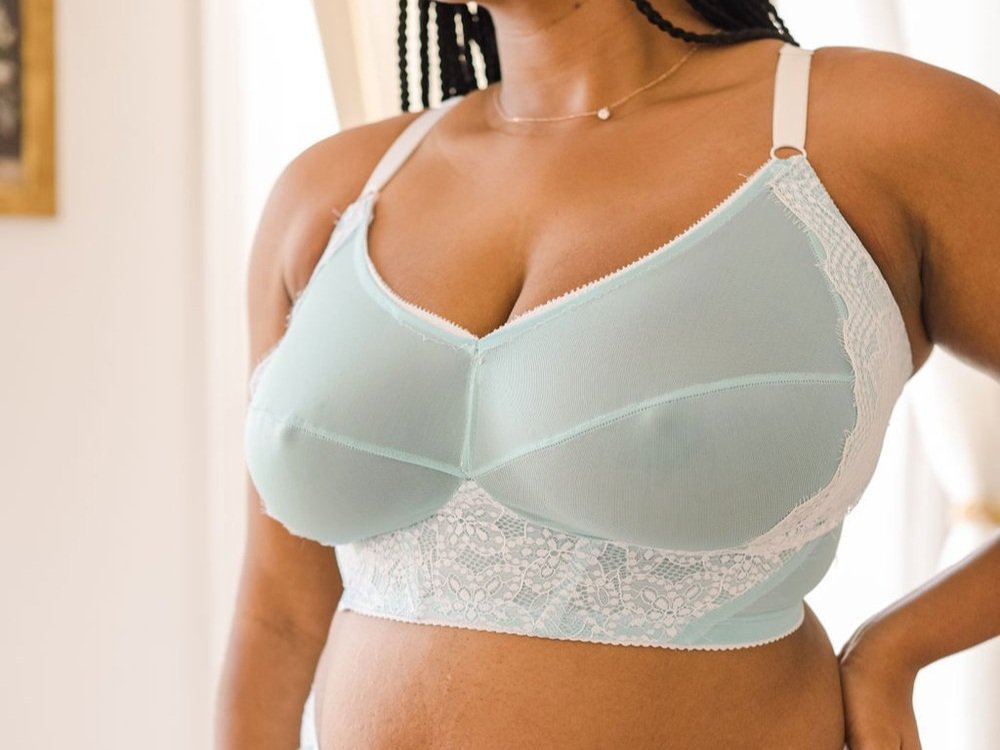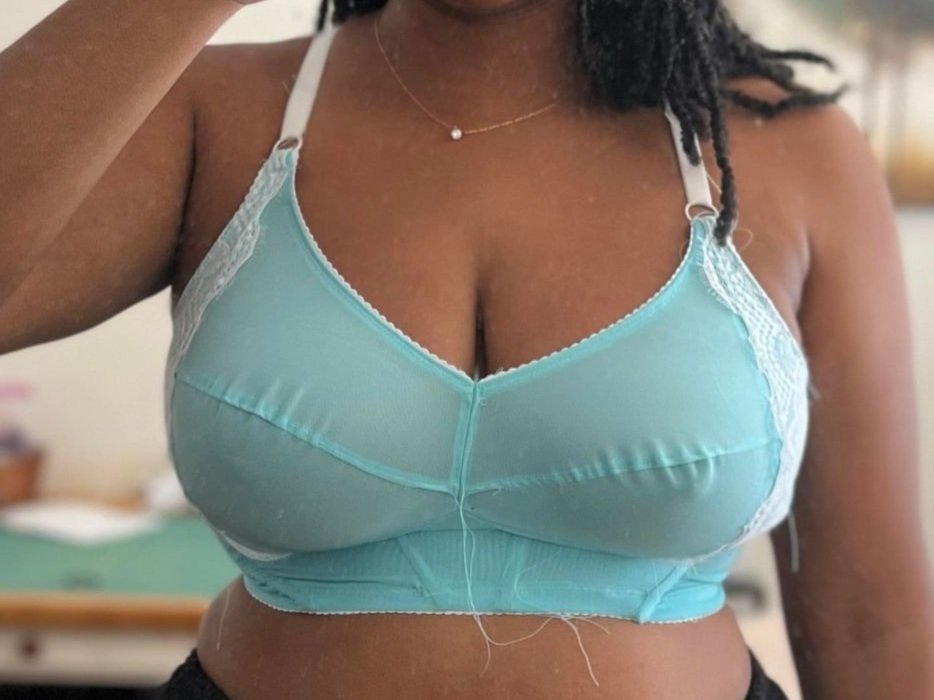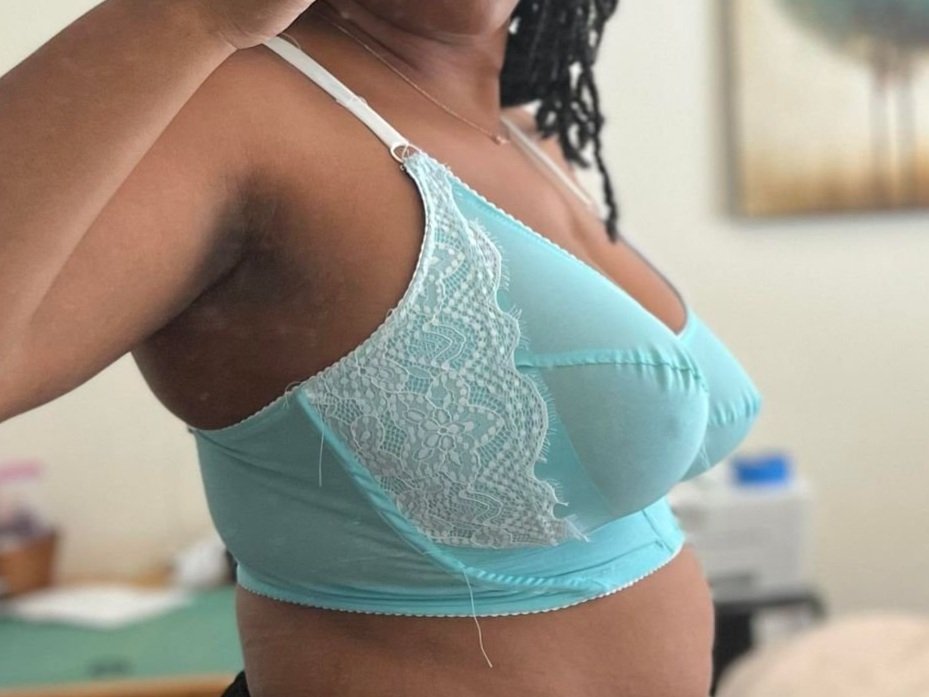Bralette Fabrics for Large/Heavy Breasts
Let’s talk about stretchy fabrics for large and/or heavy breasts. With the popularity of comfy, lounge bras during and post pandemic, what does fabric have to do with support for larger cups? Plenty. While this post is geared for the Momiji Bralette the info may be applied to similar bralette styles.
Quick review:
👉Did you know that for someone who is a 32K (UK) 32O (US), the total weight of the breasts is nearly 11 lbs (4.8kg)?
👉Keeping in mind that cup sizes are not static, a K cup could weigh 8.2 lbs (4.7kg) on a 28 band and up to 20 lbs (9.1kg) on a 44 band!
Bralettes are not only wireless, but they also DON’T have as many support structures built in (compared to wireless bras) and are thus EVEN MORE reliant on fabric for support.
Momiji Bralette Pattern in GG-KK size set
The main things to consider when buying bralette fabrics for large cups:
⭐️Fabric weight, fiber composition and rebound
⭐️Fabric grain
⭐️Follow Pattern Recommendations
FABRIC WEIGHT, MATERIAL FIBER, KNIT & REBOUND
The ability of a fabric to snap back to its original shape is known as Rebound and in the world of lingerie, is directly related to support. There are several factors that influence fabric rebound. They include the fiber composition, knit structure and any fabric finishes. In general, the more elastane/spandex, the stronger the rebound.
A quick interlude about the difference between Knit Rebound and Fiber Rebound. The mechanical stretch from a warp knit fabric (selvedge to selvedge) is simply due to the loops being taller than wider. Larger loops have larger holes and more “give” - some examples of this include rib, purl, interlock, tricot and raschel. This is also the reason why tricots or cup linings from different vendors may have different amounts of mechanical stretch. Some of our favorite fabrics have elastane blended into allowing stretch in the other direction (weft) as well. The rebound from the elastane fibers is much stronger than from the knit on its own.
FIBER COMPOSITION
Sticking with fabrics that has a high elastane content is not enough to guarantee proper support despite having good rebound. Its about finding the right synergy of materials (fiber), knit structure (tighter/looser) and fabric weight - with a stretch percentage that matches the pattern requirements. A great example is the difference between medium and lightweight powernet where the composition remains the same (80/20 nylon spandex blend) but one has weight of 90gsm and the other is 180gsm. The 90gsm powernet will have good rebound but also stretches 100% (or more) compared to the 180gsm powernet with good rebound but has 50% stretch.
FABRIC WEIGHT
Its important to note that not all fabric weights are equal. Cotton lycra that is 200 gsm (5.9 oz) and 20% spandex will behave very different than Powernet that is 200 gsm (5.9 oz) and 20% spandex. Same with swim lycra. (If you have your heart set on a specific print, line your bralette in the appropriate material to ensure proper support and shape retention.)
This may lead some people to go too far in the other direction and use a fabric that has TOO LITTLE stretch or double up an appropriate fabric in hopes of maximizing support. In non-stretch bras, this is a wonderful tactic that works really well for non-stretch bra cups. Unfortunately, when it comes to stretchy bralettes, that often means the cups become too small as the stretch percentage of the fabric is now SMALLER than what the pattern was drafted.
KNIT STRUCTURE
The type of knit (fabric structure) also plays a role in how supportive a bra remains throughout the day. In the same way that different types of weaves behave differently in wovens, different types of knits also behave differently. A good example is swim lycra. Many swim lycras have the same fiber makeup, weight and stretch percentage as powernet but do not offer the same type of drape and support. This can work fine as a substitute in smaller cups but not so much larger cups. Imagine the support of a bralette made in fishnet vs powernet in the same fiber, weight and stretch percentage.
Momiji cut on the wrong grain. Gore float, wrinkles, less coverage.
Momiji cut on the wrong grain. Wrinkles, cup shape, less coverage.
FABRIC GRAIN
The grainline of the fabric is just as important in lingerie making as outerwear but perhaps more subtle due to the smaller pieces of fabric. In clothing and swimwear, the direction of stretch usually goes around the body. This remains the same for bra bands but will differ for the cups depending on usage and intent. Sports bras often have a horizontal direction of stretch in the cups to maximize support and compress the breast tissue. Bralettes often use a vertical direction of stretch to maximize comfort and allow the cups to follow the contours of the breast better. Wireless bras can have a mix of horizontal and vertical in different parts of the cup.
Some people may be inclined to switch the stretch direction of the bralette cups to maximize support. Doing so will also result in a too small cup as the bra cup needs to stretch more in one direction, giving an increase in the east/west phenomenon and decreased cup separation. It also affects cup height, shaping and wrinkles (check out the photos!) For those with softer breast tissue, there can also be an increase in the duck lips effect due to the compression. How then, do we increase support of a stretch bralette cup with vertical stretch? Internal support structures! These often find in 2 formats: fusible interfacing or a separate sling/ halo.
FOLLOW PATTERN RECOMMENDATIONS
When in doubt, check the pattern recommendations! Most sewing patterns include fabric recommendations in addition to yardage and placement. Some patterns include specifics like stretch percentage, fiber makeup and/or fabric weights which is a big help when online shopping.
For those feeling more adventurous, one can always try working with fabrics not typically recommended for lingerie use (Ponte De Roma anyone?) and conduct your own experiments! Just remember that this is uncharted territory and may involve a lot more trial and error. In this regard, keeping some type of sewing project record - complete with fabric information - may prove quite useful. Remember that at no point should your stretch fabrics be stretched to the max. Max stretch in the band usually indicate the need to size up. Max stretch in the cups usually indicates a different fabric or internal supports are needed.
Happy Sewing!




